"All art fades, but sex fades fastest"
 Monday, September 16, 2019 at 07:34PM
Monday, September 16, 2019 at 07:34PM THE LIFE AND WRITING OF EVE BABITZ
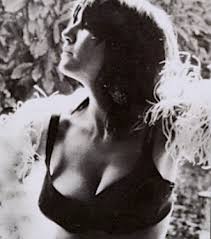
“I looked like Brigitte Bardot and I was Stravinsky’s goddaughter.”
Critics often compare Eve Babitz to Joan Didion. But Eve Babitz is nothing like Joan Didion. Eve Babitz loves sex.
And drugs. And rock and roll and drinking and beauty and glamour and style and charismatic, accomplished guys and Hollywood. Babitz passionately embraces everything Didion despises, especially joy and abundance.
For graceful sentence-making, dead-on cultural parsing, astonishing common-sense insights and ruthless social anthropology, only Didion and Renata Adler compare to Babitz. But Babitz, whose books from the 1970s have only recently been brought back into print by the New York Review of Books, never garnered the serious literary cred in which Didion and Adler rightfully bask.
Maybe because Babitz’s subject matter – mad sex, drugs, rock and roll, drinking, beauty, glamor, style, accomplished, charismatic guys, and Hollywood – wasn’t deemed sufficiently serious, few recognized the poetic depth of Babitz’s insights. Maybe because she had too much fun writing and living, Babitz never vested in the astringent, antiseptic distance from which Didion and Adler eviscerate. Babitz wrote from the eye of the storm, a storm she most likely created. Her knives were as sharp as Didion’s and Adler’s, but always tempered with compassion and wit. And, often, lust.
Almost everyone who writes about Babitz – both in the 1970s when her books were first published and recently upon their re-publication – regards her as they would a talking dog. Surprisingly, even women writers default to the talking dog position. They first describe Babitz – accurately – as hot, brazen, stylish, wild, brilliant and untamable. Then they talk about her top-shelf remuda of absurdly famous lovers. They always cite those lovers. Then and only then do they mention Babitz’ astute perceptions, her moral and artistic courage, her singular voice – and that with astonishment. They take the tone that this modern-day Venetian courtesan had no right to write like a genius.
Babitz touches on this dilemma in her writing on Marilyn Monroe, with whom she was mildly obsessed. It infuriated her that everyone regarded Arthur Miller as a jewel in Marilyn’s crown, rather than her as a jewel in his. Babitz regarded Marilyn as something she would never, ever be: an ingénue. Babitz could never be an ingénue, she writes. Ingénues are doomed because they insist on being undervalued.
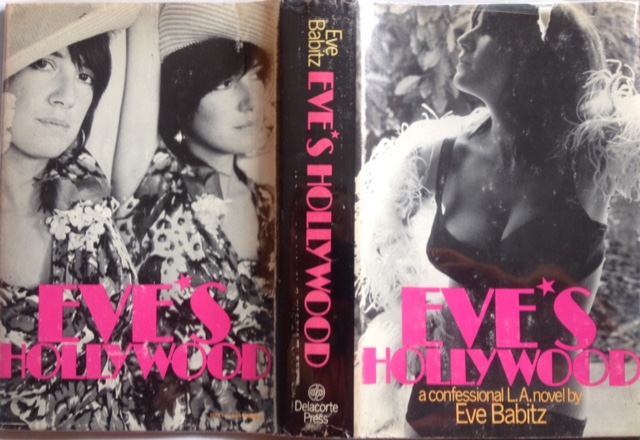
The ingénue’s role is of the lamb to the slaughter, a lamb who pretends innocence as a dreadful, instinctual, inescapable collusion with her butcher. That collusion, Babitz thinks, is crucial to an ingénue’s charm – the ability to act like no one is hurting you even as they sever one limb after another. Babitz expresses awe at both how long Marilyn let her butchers chop away and how untarnished Marilyn remained. Only a select few in Eve’s Hollywood remained untarnished.
Babitz never regards herself as so. Her understanding of the rarity of being uncorrupted by Hollywood, rock and roll, style, glamor, money and success led Babitz to a profound appreciation of the corrupt. She admired and, for a while, enjoyed the company of those who avoided the middle steps of attempting to hold onto innocence and failing. The truly corrupt did what the ingénue could not: They embraced and paraded their strengths, behaved as they wanted and ignored the toll others paid for their corruption.
In the first half of Sex and Rage, which features little straightforward depiction of either, Babitz describes falling into an international haut demimonde that had descended, in their unending circuit around the globe, upon LA. Night after night and week after week of morally, socially and emotionally complex debauchery followed. Babitz finally totaled up the rent this demimonde demanded when, on the way home as the sun rose, Babitz realized she had consumed fourteen White Ladies – a cocktail most likely made of gin and Cointreau – in a single evening. From that moment, Babitz began, despite the sex, fun, style and glamour available, to extricate herself from that world. Looking back from a survivor’s distance, she understood of the demimonde that “most of the girls they used for local color died before they were thirty.” All those girls attempted some version of the ingénue’s gambit.
Babitz acknowledges the ingénue’s power. The ingénue knows that when someone falls for her innocent act – and 99.99% of them are dudes – she can get away with murder. The ingénue also knows that those who throw themselves on the pyre of her performance of innocence will take care of her. That’s the ingénue’s pendulum; she swings between the sucker and the butcher. There are no other options.
Babitz sought neither suckers nor butchers. She evokes Tina Fey’s self-descriptions: Babitz never entered any social situation feeling or acting like an underdog. Igor Stravinsky is her godfather, for crying out loud; Stravinsky named her! Babitz grew up in a family of intelligent, good-willed bohemians who only wanted her to be true to herself.
Consider nineteen-year-old Babitz naked playing chess with Marcel Duchamp, in a photograph that started as a goof and became an icon. Look at that woman, naked with her identity shrouded by hair: She don’t lack for confidence. She knows how to be simultaneously a person and a persona. She knows how to revel in and withhold her sexuality. She is at ease in the most ridiculous and profound of circumstances. All this comes through in Babitz’s prose, even when she writes movingly of her own recurring social terror.

Babitz describes herself as surfer moving through the world with a surfer’s balance and a surfer’s eye for which swells to catch and which to let flow beneath her. What stirs her soul are people like her, who could only be themselves, just bigger. She admires songwriter J. D. Souther when he tells her he spent his first year in Los Angeles “learning how to stand.” Babitz’s famous lovers were all men who studied themselves and the waves of their chosen oceans with care and cunning and created the persona that would let them ride the crests to where they wanted to go. Their skill and self-directed ruthlessness enthralled her.
Of course, I’d like to tell you about the stars – and I mean stars – of art, comedy, rock and roll and Hollywood that became Babitz’s handpicked boyfriends. How she almost always chose them before they were famous and how she nurtured, encouraged and guided them as their lives exploded. It’s some juicy gossip and contextualizes Babitz’s 1960s/‘70s hellraising and allure as few examples could. But if I tell you, you might think I’m suggesting that her queue of world-beater boyfriends might be jewels in her crown and not vice versa. That those famous names gave her credibility… If I write about whom she fucked and loved, I’d be calling her a talking dog: a woman with famous boyfriends who happened to write. And that ain’t right. Babitz is a writer. Her personal life is her business. A business she wrote about in granular detail. Them boyfriends are all front and center, if you can suss the clues.
Please, join me in discovering whether I get to the end of this piece without listing her boyfriends and the telling, tragic, harsh, loving and riotous things she wrote about them. The suspense is killing me.
Here’s a hint:
She writes that Val Kilmer could never portray Jim Morrison accurately because Val Kilmer had always been a prince. Since high school, when the princely Val Kilmer walked into a room, every woman there wanted to lick the sweat off his neck. This was not true of Jim Morrison. Growing up, Jim Morrison was a fat, lonely, picked-upon, bookish nerd from the sticks with delusions of grandeur. Then, one magical day, according to Babitz, Morrison discovered speed, among other drugs, and lost a shit-ton of weight. Overnight, he became a prince. Overnight, women who had ignored or scorned him for the first twenty years of his life were mega-hella hot for his bod. Overnight, women he never thought he had a prayer of nailing begged for a moment, just a moment, of his attention. This, as Babitz points out, might really fuck up a former fat nerd’s head. It fucked up Morrison’s big-time. He became a screaming, pretentious asshole, as who among us would not? Babitz maintains that no one who is born beautiful – like Kilmer – could ever understand the identity-shredding pathos of becoming beautiful.
“In L.A. when someone gets corrupt, it always takes place out by the pool.”
Babitz writes with delicacy, obliqueness and brutal directness about Gram Parsons, with whom she was close. Unlike most writers, she spends little time on his music. She focuses on his grace, incongruous charm, well-mannered remove and refusal to be motivated to do anything. She touches with empathy but never respect on the paradox of a genius who had too much money to care whether he ever manifested his gifts. Unsurprisingly, when Babitz writes about Gram, she also writes about cocaine. On the, ahem, cutting edge as always, Babitz had her first private encounter with Gram in his suite at the then-moldering Chateau Marmont. As she came into the suite, Gram – whom Keith Richards described as having “better coke than the CIA”; and Keith oughtta know – was bent over the living room table, chopping fat rails of uncut German pharmaceutical right out of the vial(s). In 1971, snorting pure German pharmaceutical from the vial(s) was not cutting edge – it was avant-garde.
In writing on Gram, Babitz posits her “Three Rules of Cocaine.” Her Rules are shocking for their clarity, accuracy, immutability and immortality. Babitz’s Rules so codify the cocaine universe that there was not then, has not been since and is not now any need for a fourth.
Eve Babitz’s Three Rules of Cocaine
1) The first time is always the best.
2) There is no such thing as enough.
3) The process of learning the truth of Rules 1) and 2) is very, very expensive.
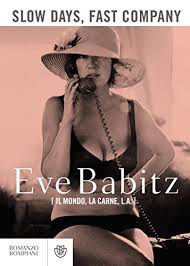
“Rosewood Casket,” probably the best-known and most-cited story in Eve’s Hollywood, concerns Gram and Keef. Incongruously, Babitz defaulted to pseudonyms. Since she names names almost everywhere else, her refusal to do so here feels almost cowardly. Perhaps she feared, for good reason, Gram’s gorgeous, ferocious, litigious 17-year-old girlfriend and later wife. Babitz describes Gram and Keith, thinner than any vampires, hanging onto each other for dear life at the Whiskey a Go Go, radiating such heretofore unseen death’s door charisma and Otherness that even the most carnivorous groupies – and groupies lined the walls and the stage at the Whiskey – hung back in dread and wonder, not daring to approach. Even for such a connoisseur of degraded, drug-soaked magnetism, the tightrope these two walked held no glamour for Babitz. She saw tragedy looming. Having long since left the demimonde, Babitz became a hard-eyed realist. When asked whether she thought Gram and Emmylou Harris had been lovers, Babitz answers ruefully, “Gram was too high to make it with anybody.” For Babitz, that was a fate worse than death.
Having fallen out of touch, Babitz was unaware of when exactly Gram took off to Nellcote to hang with Keith as the Stones recorded Exile on Main Street. And she was taken by surprise when Gram returned a shell of his former self. She describes going into shock when she was told: Gram got fat! After seeing him, she inflicted upon Gram the worst insult anyone suffers in these three books. He looked, Babitz writes, like a fat southern cop. No one could look worse than that.
This is not a superficial response. It’s a nuanced, Henry James/Oscar Wilde response – a tragic insight, one that broke Babitz’s heart. She wrote that anywhere other than the LA rock and roll scene or the offices of Vogue, Gram would not be regarded as a fat guy. He’d be a normal guy. But for the god of glamor Gram once was to show up on Olympus – the Whiskey – looking like a fat southern cop meant the end. The end of self-awareness, of self-control, of self-regard, of self-salvation. Babitz knew, and in saying no more than that Gram got fat, makes clear that Gram had sunk to a depth from which he would not and could not surface. And Gram never did.
“I don’t believe in facing pain unless it’s the kind you like.”
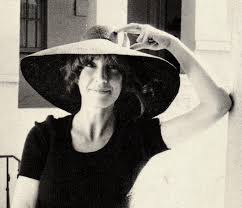
In common with Gram, Babitz sought only the coolest, most rigorous scenes that demanded the most skillful artifice laid atop the least self-conscious naturalism. In those scenes, you had to be yourself, only more so. There, as Babitz depicts with compassion and schadenfreude, the self-conscious flounder. Phonies flourish, but only on the strength of their a) drugs or b) ability to amuse. Those scenes undid Gram, maybe because the scenes he chose revolved around proving your mettle by creating great music. Babitz hung in those scenes with ease, and she hung in scenes where she proved her mettle by using the right fork or delivering the killer bon mot at 6AM after a long night of fucking, cocaine and opium.
Babitz enjoyed blocked geniuses, like Gram. She adored and cared for doomed beauties, who are legion in her books and as Hollywood as bougainvillea. But genii who never get it together and gorgeous women broken by their own beauty don’t engage Babitz’s close attention. Those people form wretched Hollywood wallpaper; they’re part of Los Angeles and always will be. The men and women who engage Babitz closely may have been worldwide platinum successes – before there was such a thing as a platinum record – or they may have been glamorous, insightful, seductive widows who sat on their silk-covered living room couches welcoming the world with unquenchable élan.
Doomed Dean Memimger, who played a couple seasons for the New York Knicks and spent most of the rest of his life as a crackhead, said the truest thing: “If you don’t play ball, you can’t hang out.” If there’s a sun of a thesis around which all of Babitz’s planets revolved, there it is. She and Dean recognize that success demands both skill sets. That’s why Babitz respects J.D. Souther for taking a year to learn to stand. Souther might have made it on his songs alone, but to catch the wave he wanted he knew he had to learn how to hang. Merely hanging won’t cut it. Hanging was like breathing for Gram, but he couldn’t get out of his own way long enough to play.
So, you learn to play ball and to hang out and when you become champion, from then on everything takes place only on your court. When Babitz’s not-yet-famous boyfriends reached that pinnacle, she lost interest.
Babitz understands that social power is the one necessary superpower. Her books explore the intricacies and subtleties of social power in numerous arenas. Those whose only power is social, like the beautiful, compel her. Babitz writes that she learned in the classrooms at Beverly Hills High, where at least 20 girls in her class were world-beater beauties, that every door opened to the gorgeous. Anywhere the beautiful wanted to hang, they were welcome. This is the true magical power of beauty, Babitz writes: not being desired; being welcome. Babitz was never jealous of that power because she always hung wherever she wanted. Being free of jealousy of pretty much everyone helps fuel her insights. Babitz, unlike most writers, never wanted to be anybody else.
Babitz is a journalist. Her books, even her putative fiction, are Babitz reporting on her life and her in it. Though she’s an excellent reporter, facts are not her métier; her métier is essence. With spare elegance, Babitz evoked the valence of a stride, a glance, a pause in conversation, a jacaranda blossom, the glint in a man’s eye, a dusty road or a glass of tequila. This gift, too, stemmed from her surfing adolescence; she grokked the ineffable long before the practical details registered. She prioritized the poetic and wrote as if that priority required no explanation.
Babitz’s greatest gift is that she can tell the difference. Few people or moments deceive her gimlet eye. Her writing reflects a central belief of her era of growing up. That belief emerges from the pioneer existentialists and the Beats: that there is such a thing as a Moment and that the astute, attuned individual can Nail it. Babitz journeyed through her life seeking Moments – or deliberately obliterating them with drink and drugs and fucking – and Nailing them. She saw as others could not. She never defaulted to cynicism. Somehow, throughout her journeys, her romantic soul endured.
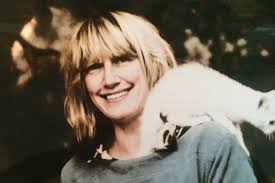
Parsing the rules, games, purpose and valence of every social scene she encounters is Babitz’s singular genius. Though her books are set in the ‘60s and ‘70s, they are not time capsules. They delve deeply into their eras, but are of every era. Babitz’s comedies and tragedies of manners are – like Wharton’s, like Wilde’s, like Waugh’s, like Austin’s, like Eliot’s, like Joseph Heller’s and like Joan Didion’s – timeless.


Reader Comments